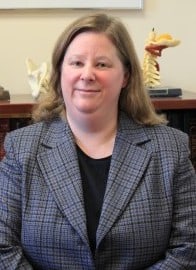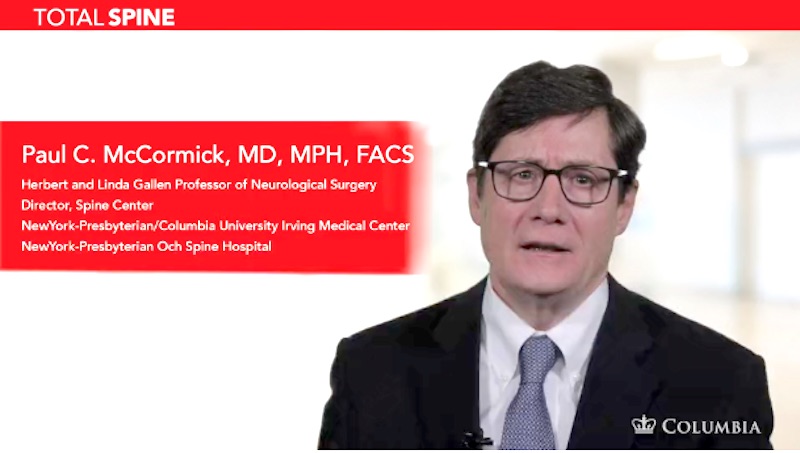Some patient stories are complicated, and sometimes ‘it takes a village’ to treat that patient. Every village needs a chief, and for Sara Gilbert Nadler-Goldstein, that chief was Dr. Paul McCormick, from The Spine Hospital at The Neurological Institute of New York.
Sara’s story of pain began in May of 2003 after her back was injured in a motor vehicle accident. “I wasn’t just in pain after the accident,” she says. “I was in writhing pain. It made all the hair on my body stand straight up.”
A medical social worker by trade, Sara knew her medical community in New Jersey and immediately sought care. She would, in fact, spend the better part of the next year trying to get rid of her pain. Instead, countless doctor visits and two spinal injections later, the pain had begun shooting down her right leg and she was having trouble walking.
“I went to my neurologist,” says Sara. “He took an MRI and he said to me, ‘You are in trouble. I need for you to go and see Dr. Paul McCormick, Director of the Spine Hospital at Columbia Presbyterian.’ I’ll never forget that day–it was St. Patty’s day, 2004.”
Two weeks later, Sara met Dr. McCormick. “He was caring and compassionate and he made me feel safe and comfortable,” she says. “He reviewed all the films and examined me. He was very thorough.”
Dr. McCormick told Sara that she had a herniated disc in her lower spine. This was causing much of her pain as well as some nerve damage. He explained that he could perform a minimally invasive surgery that would relieve the pressure and hopefully allow the nerve to heal.
Sara remembers, “I signed the papers for the surgery that day. I don’t think most people go for a consultation with a neurosurgeon and sign on the dotted line that day, but he made me feel so safe and secure. I knew I could sign my life over to him.”
On the day of her operation, Sara says, “I was scared and in pain. I had never had surgery before. When I first got in the operating room, there must have been about 25 people and I got really overwhelmed and started crying. They got me on the table and I said, ‘I need to ask each and every one of you what your role is going to be while you are in this room with me.’ Dr. McCormick was in the room and he said, ‘Sara, don’t worry, do what you need to do.’ And you know what? They went around and told me, ‘I’m the scrubber, I do the count, I will be monitoring your meds, scrubbing etc.’”
Included in the group was Dr. Peter Angevine. He was there to assist Dr. McCormick with the surgery. Sara continues, “After everyone went around, I turned to the anesthesiologist, who was so kind and patient, and I said, ‘James, you can put me to sleep now.’”
Several hours later, Sara woke up. “I had the most magnificent view of the George Washington bridge that night,” she says. “You know how you come out of anesthesia with one eye open and one eye closed?–I remember Dr. Angevine came up that night to see me and I said to him, ‘Doctor how did I do?’ and he said, ‘Sara, everything is taken care of and you are going to be OK.’ He was just very comforting, very soothing, and very reassuring.”
By 8:00 the next morning, Sara was up and out of bed and by 2:00 she was on her way home.
“I feel like Dr. McCormick saved my life that day,” says Sara. “He gave me a life to go back to–a quality of life. Before I met Dr. McCormick, I was in so much pain.”
Dr. McCormick continued to monitor Sara over the next year as she healed.
Recently Sara made the long drive from her home on the Jersey Shore into the city to the Spine Hospital. This time she was there to see another colleague of Dr. McCormick’s, physical therapist Dr. Evan Johnson. She says, “I came to get some exercises to keep my back strong. Evan was wonderful, kind and compassionate.”
The drive was worth it she says,“because of the one-on-one individual care. Before care begins there is collaboration with doctors at Columbia and a thorough review of my medical records. This enables the best treatment possible and I was privileged to benefit from that.”
Today Sara says she is doing great. “If you saw me in the street, you would think I look like a fantastic middle aged woman–you wouldn’t be able to see that anything was done or that I have any medical conditions.”
Sara says she owes this all to Dr. McCormick. “He is the leader in this. He left no stone unturned and sent me to the most fantastic doctors. They were so carefully matched to my personality and where I was at. If it wasn’t for all of their devotion to excellence in medicine I would not be where I am today.”



